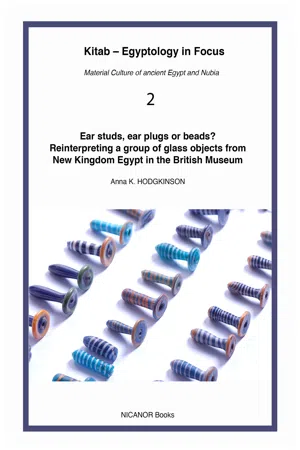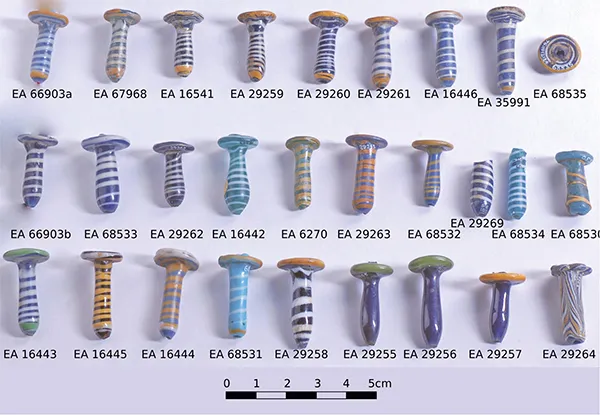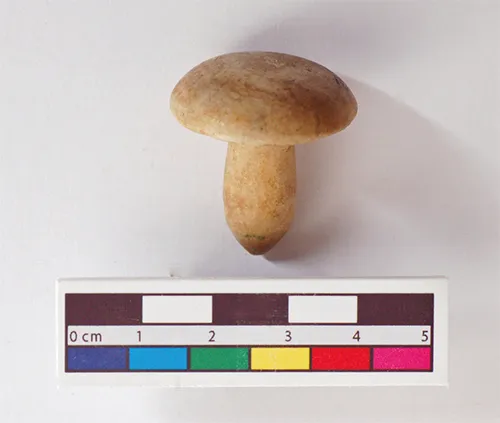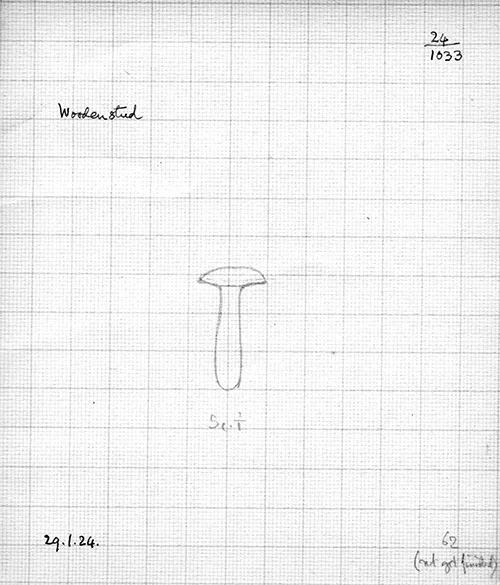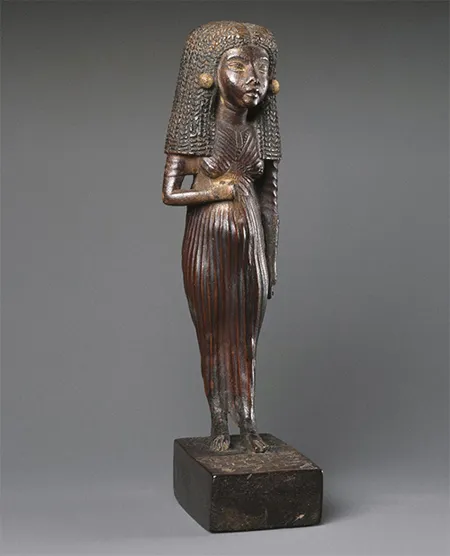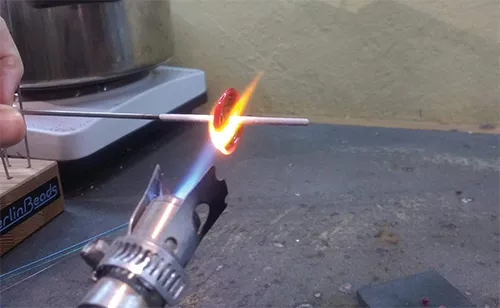![]()
1 Abstract
This short volume discusses a group of glass objects kept in the British Museum that date to the Egyptian New Kingdom (1550–1069 BC) and are commonly referred to as ‘ear plugs’ or ‘ear studs’. Ancient Egyptian ear studs from a variety of materials appear in the archaeological record and are usually depicted as worn with a convex dome to the front. However, there is evidence to suggest that the glass objects discussed in this volume, and which are similar, but not identical, in shape to ear studs, were not designed as ear jewellery, but that they actually functioned as beads or amulets. The objects are flat-fronted and pierced latitudinally. The piercing, which is related to the manufacture of the objects on a metal rod, would have enabled the objects to be threaded and suspended vertically, either as parts of garments, as parts of bead chains, or individually.
![]()
2 Introduction
This volume discusses a group of 28 glass objects from Egypt (fig. 1) kept in the British Museum (Department of Ancient Egypt and Sudan) that date to the New Kingdom (1550–1069 BC)1 and are traditionally referred to as ‘ear plugs’ or ‘ear studs’ (fig. 2). No real or in-depth discussion of the purpose and function of these glass objects, which are frequently found within New Kingdom settlement sites, exists, necessitating a classification and internal typology together with a discussion of their function and manufacturing techniques, and these are included in this volume. The author argues against their categorical interpretation as items of ear jewellery, based on their appearance and manufacture.2
Fig. 2: The objects in the collection of the British Museum, analysed for this study. Photo: author. Courtesy Trustees of the British Museum.
Ancient Egyptian ear studs are usually mushroom-shaped and depicted as worn with a convex dome to the front. They are included in the archaeological record and exist in a variety of materials. However, there is evidence to suggest that the glass objects discussed here, and which are roughly similar in shape to such ear studs, were not necessarily designed as ear jewellery, but that they actually functioned as beads. These objects are usually flat-topped or -fronted, latitudinally pierced and, as will become apparent in due course, papyrus-column shaped. While the piercing can be said to be related to the manufacture of the objects on a metal rod, there is reason to believe that at least the unsightly frontal hole would have been sealed were these objects to be worn through the ear lobe.
2.1 Ear jewellery in ancient Egypt
Ear jewellery was probably not worn in ancient Egypt until the Middle Kingdom (2055–1650 BC).3 It became popular during the Second Intermediate Period (1650–1550 BC), when it was probably introduced by the Hyksos, some of the earliest examples of ear jewellery making an appearance during this period.4 Shortly after, people depicted as partaking in festivities in paintings from Eighteenth Dynasty (1550–1295 BC) non-royal tombs are frequently shown as wearing large pieces of ear jewellery from gold or faience: an example of this can be seen in the paintings from the tomb of Nebamun (TT 17), now in the British Museum.5 In addition, reliefs and pieces of sculpture depicting members of the Eighteenth and Nineteenth Dynasty (1295–1186 BC) royal families, often show only the pierced lobe (which is usually not pierced through), without the indication of ear jewellery, simply representing the facility for wearing an ornament. This phenomenon occurs particularly frequently during the Amarna Period, during which Akhenaten (1352–1336 BC) himself, and other members of the royal family, including Queen Nefertiti6 and some of the princesses,7 are depicted with pierced lobes. Prior to this, Akhenaten’s father, Amenhotep III (1390–1352 BC), may also be represented with pierced ears,8 and the mummy of Tjuyu, the mother of Tiye (the wife of Amenhotep III) was found to have pierced ear lobes.9 It is not certain whether these hollows, at least in composite sculpture, would have been inlaid with ear jewellery from precious materials or glass, but it is possible that only the pierced lobe was intended to be displayed.
Fig. 3: Calcite ear stud EA 2712 (British Museum). Photo: author. Courtesy
Fig. 4: Faience ear stud EA 59306 (British Museum) from Amarna. Photo: author. Courtesy Trustees of the British Museum.
As mentioned above, ear studs from a variety of materials occur in the archaeological record, usually in settlement contexts, both of a domestic nature and in burials.10 Materials include stone (frequently calcite / alabaster / travertine: fig. 3, but also others), faience (a sintered quartz-based material, usually with a white core: fig. 4), glass, metal and bone.11 Even two examples from wood are known from Amarna (fig. 5), although more may have existed, organic materials having the tendency to decay.12 Some very high-status pieces of composite ear jewellery are known, including some examples from the tomb of Tutankhamun (KV 62), and these are made from dark red resin with inlaid limestone, calcite and red pigment.13
Ear ornaments occur as three-dimensional applications on coffins and statuettes. The wooden statuettes of Mi (fig. 6),14 Tuty15 and that of an unnamed lady16 from Gurob wear carved and gilded convex ear studs, and such items have also been depicted on coffins and mummy cartonnages, such as that of of Katebet,17 for example. A further example of members of the elite being represented with ear jewellery are the two plaster cast heads of women from Amarna.18
Fig. 5: Wooden ear stud excavated in the Main City at Amarna. Find number 24/1033. Archive reference number TA.OC.23-24.1033. Courtesy of the Egypt Exploration Society.
Fig. 6: Lady Mi, ca. 1390-1353 B.C.E. Wood, bone?, gold leaf, 6 1/8 x 1 3/4 x 2 1/4 in. (15.6 x 4.4 x 5.7 cm). Brooklyn Museum, Charles Edwin Wilbour Fund, 47.120.3.
Ear jewellery has also been depicted in tomb scenes including those of the royal consorts Tiye19 and Nefertari:20 In both cases the ear studs shown are mushroom-shaped, convex (i.e. domed at the front) and bulging from the ear lobe. Tiye is depicted wearing ear studs that have an appendage hanging down the back of the lobe, stretching towards the shoulder. The Berlin head of Tiye is also adorned with drop earrings from gold with embedded uraei.21 In some of her tomb scenes Nefertari is shown wearing cobra-shaped ear jewellery, and in these depictions there is also an appendage similar to that found in the depictions of Tiye. It is not certain what material this appendage may have been made from, and no examples have been found in the archaeological record. Nefertari’s bulging ear studs appear not to have this appendage, possibly depicting simpler, mushroom-shaped ear studs. The evidence which contradicts the interpretation of the glass items discussed in this volume as ear ornaments is presented and discussed in chapter 5.
Fig. 7: A disc bead being shaped by the author on a mandrel, using modern lamp-working technology. Photo: author.
2.2 Manufacture and appearance
The manufacturing technique used for the glass items discussed here is that of rod-forming. Like glass beads, those objects traditionally classified as ‘ear plugs’ or ‘ear studs’ were fashioned around a metal rod, known as a mandrel.22 In order to produce beads, glass rods that had been heated to a temperature between 850–950° C, at which point they reached a viscosity that allowed the glass to be manipulated, were wound around the copper-alloy rod. This technique is not dissimilar to that used for the production of glass vessels during the New Kingdom known as core-forming, which involved the packing of a clay and sand core around a metal rod, around which the glass was built up.23 Because of the hot and narrow flame (the so-called ‘torch effect’) required for melting the gla...
